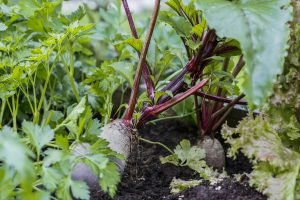
The government is now recommending we have 10 portions of fruit and veg per day, but the costs can add up. So why not try and grow your own veg this summer? Now is the time to get plots ready and plan your crop for the summer. Over the last few years, there has been a tremendous surge in the popularity in growing your own vegetables and the demand for allotments has increased with many councils having long waiting lists. But you don’t necessarily need lots of space to grow your own vegetables, and there are some easier options to get you started if you’ve never tried to grow veg before. Whatever size or space you have whether it’s a small patch in the garden, a container, flat or raised beds getting your soil ready for planting and planning what you’ll sow is vital for success.
March is the time for planning and preparation. Cleaning up and clearing out any vegetation left over from last year and getting the soil turned over with a nice tilth (prepared soil surface). You can also make sure water butts are positioned under down-pipes to harvest rain water ready for use over the summer.
Once preparation is done planning is key to a nicely managed and sustained vegetable season. You need to decide what to grow, work out how to divide the space you’ve got, and then plan when everything needs planting. The RHS has a great downloadable vegetable planner on their website to help you decide what to plant, when that needs to be sowed and when it will be ready to harvest. For example, broad beans, beetroots and Summer cabbage can be sown outside from March onwards once there are no more frosts.
Bear in mind that you might want to sow in succession, in batches, so that they come steadily throughout the Summer and you don’t get a glut of the same produce. Here is where taking the time to plan your vegetable garden really pays off.
If you are a first-time vegetable grower consider starting out with salad, courgettes, onions, shallots, garlic and beans. Salad is very rewarding to grow as you cut it as you need to eat it and it keeps growing back; everyone loves a salad. Courgettes grow every easily and can be prolific and they are such a versatile vegetable for cooking in savoury dishes and even chocolate courgette cake. Onions and shallots are a staple ingredient for most cooks and low-growing dwarf French beans and runner beans are also easy to grow and delicious to cook straight after picking.

Getting children involved in growing vegetables is a great way to get them to try new foods and give them a sense of achievement at having grown something themselves. Radishes (although maybe not an obvious favourite) are perhaps the easiest thing to grow with your children, alongside tomatoes that can be grown straight from growbags a little later in the year.
So, whatever your experience with growing vegetables or the size of your garden, patch or container there is a solution for you. For those who are looking to create new raised beds or re-organise your garden to really get serious about growing your own, now is the time to be getting the hard landscaping done and the soil ready to sow. That’s where experts like ourselves come in to make sure you have exactly what you need for what you want to achieve.
I hope I have inspired you to start thinking about the vegetables you can grow this year and to get out there and start preparing and planning. It is still a little too cold for many things but if you have a greenhouse or want to start cultivating seeds inside then again now is the time.
We look forward to seeing your efforts, please do share any images with us on Facebook, at greenartoxford and keep in touch with our current projects, gardening advice and what’s happening in our world by signing up for our regular newsletter on our website.








